Rennie Scaysbrook | February 8, 2019
Yamaha’s little cash cow, the 2019 Yamaha YZF-R3, has come in for a makeover for 2019. They’re subtle changes, but it all adds up to another great little blue bike.
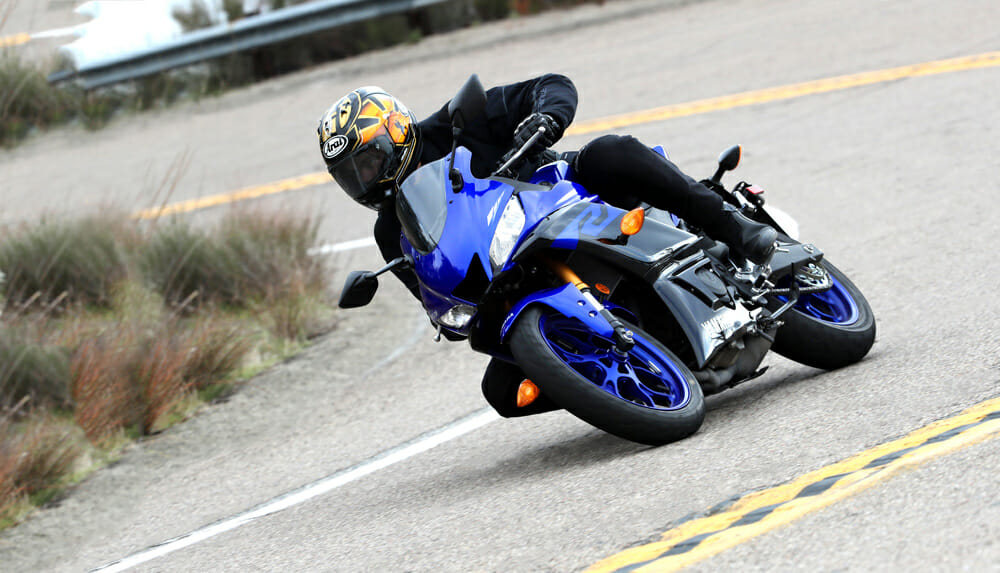 Pick a line and carve it: the revised R3 loves being on its side.
Pick a line and carve it: the revised R3 loves being on its side.
In the four years it has been available in the U.S., Yamaha’s 321cc YZF-R3 has shot to the very top of the company’s top-seller list. Almost 20,000 of these little twin-cylinder sport bikes have found more new homes in that time than the YZ450F, the Star Venture or the MT-07. It’s a firm middle finger to those who say sport bikes are dead in the water.
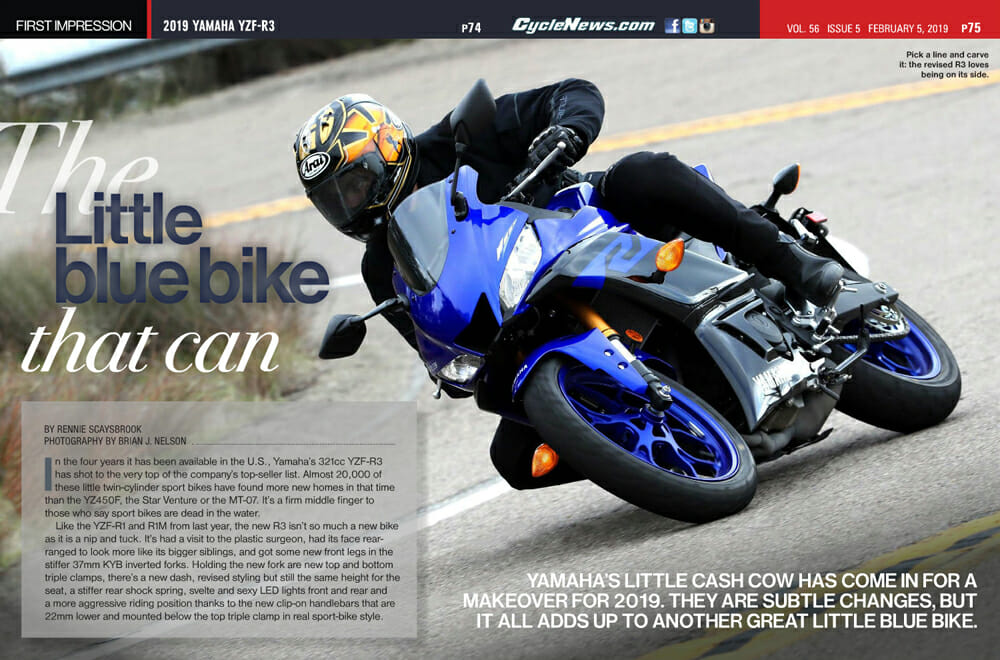
Photography by Brian J. Nelson
Like the YZF-R1 and R1M from last year, the new R3 isn’t so much a new bike as it is a nip and tuck. It’s had a visit to the plastic surgeon, had its face rearranged to look more like its older siblings, and got some new front legs in the stiffer 37mm KYB inverted forks. Holding the new fork are new top and bottom triple clamps, there’s a new dash, revised styling but still the same height for the seat, a stiffer rear shock spring, svelte and sexy LED lights front and rear, and a more aggressive riding position thanks to the new clip-on handlebars that are 22mm lower and mounted below the top triple clamp, ala real sport bike style.
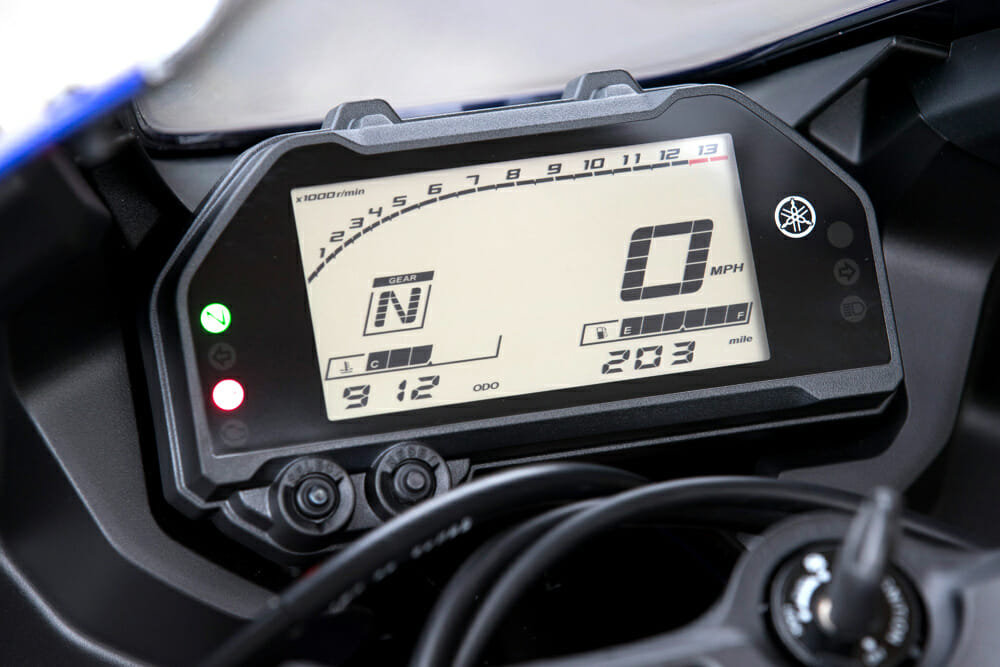 The new dash is all digital and super easy to read and use.
The new dash is all digital and super easy to read and use.
The gas tank retains the same capacity at 3.7 gallons but it too is 20mm lower and 31mm wider above where the rider’s knees sit to make it easier to brace yourself under braking.
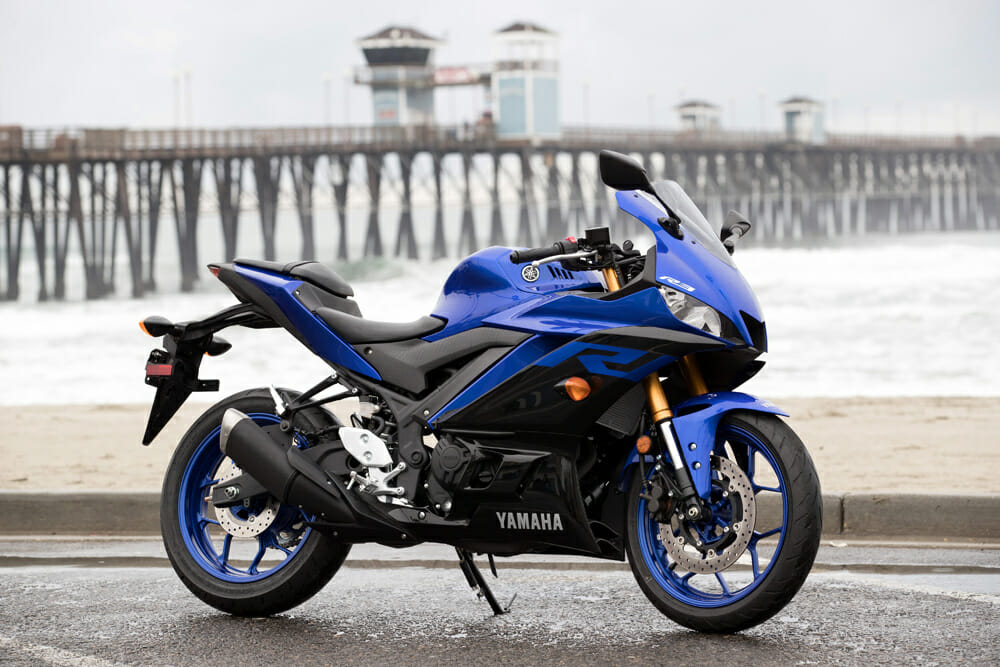 Mechanical changes aside, the new R3 looks the business and very much like the R6 and R1.
Mechanical changes aside, the new R3 looks the business and very much like the R6 and R1.
What most will recognize before anything else when viewing the new R3 is the completely revised styling. This is a deliberate act of family lineage from Yamaha, who had a bit of a redheaded stepchild in the first-generation R3, as it didn’t really look like the R6 or R1, and, thus, a bit out of place.
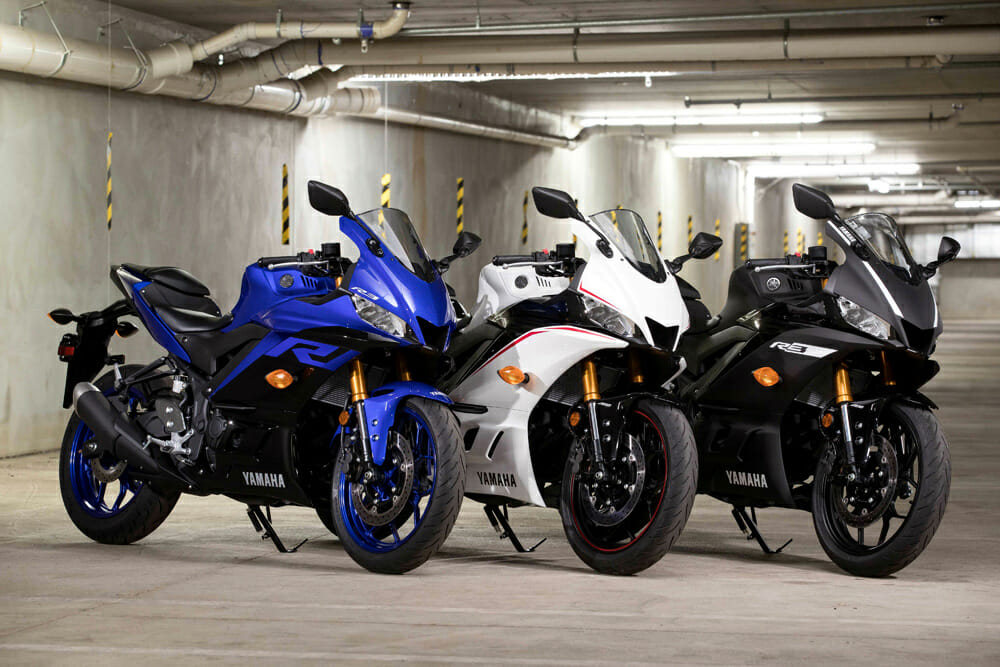 The family R3. Each bike looks great but you can’t get an ABS R3 in blue, only white and black.
The family R3. Each bike looks great but you can’t get an ABS R3 in blue, only white and black.
The fairing now sports the same intake design as its older brothers and the top fairing cowl is now a more traditional design with the mirror placement and screen looking much more like the R6’s.
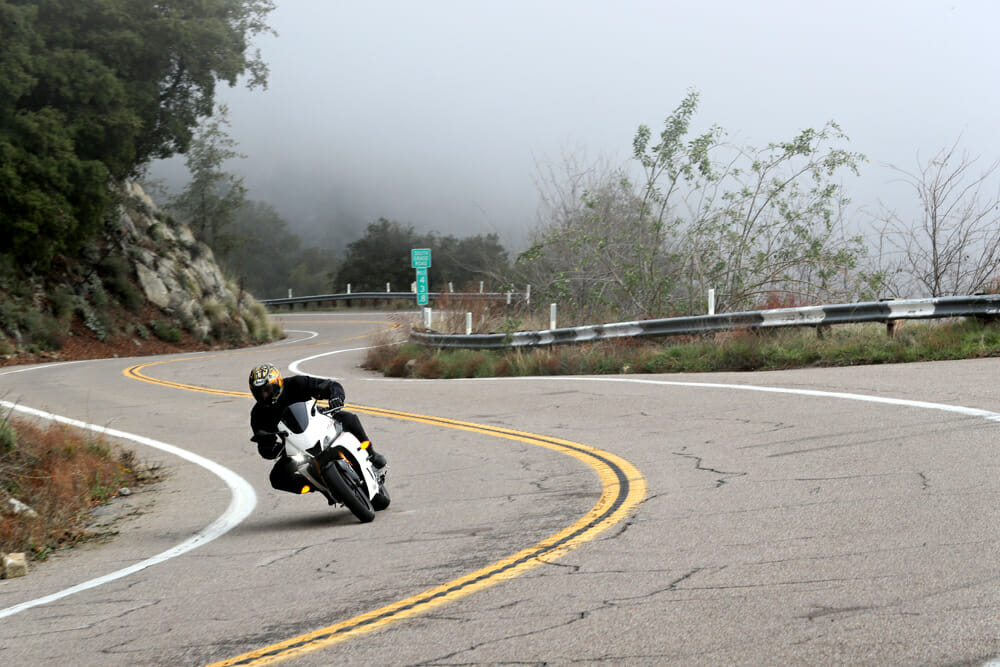 Cold and wet conditions gave the Dunlop tires a good chance to shine.
Cold and wet conditions gave the Dunlop tires a good chance to shine.
Yamaha’s decision to change the styling is more than just a mechanical exercise: they are hoping to get the R3 rider early, get them pumped about riding a Yamaha sport bike and keep them in the family with their next bike being an R6 or R1. Brand loyalty is hard to come by in the sport bike game—riders are always looking for the next fastest thing so any way Yamaha can keep them in the family, they’re going to exercise it.
Compared to the 2018 edition, this R3 feels much more track focused before you even turn the key. The revised riding position and the new clip-on bars angle the rider more towards the front wheel, which has the added effect of loading up the new Dunlop Sportmax GPR-300 tire to increase your turn speed.
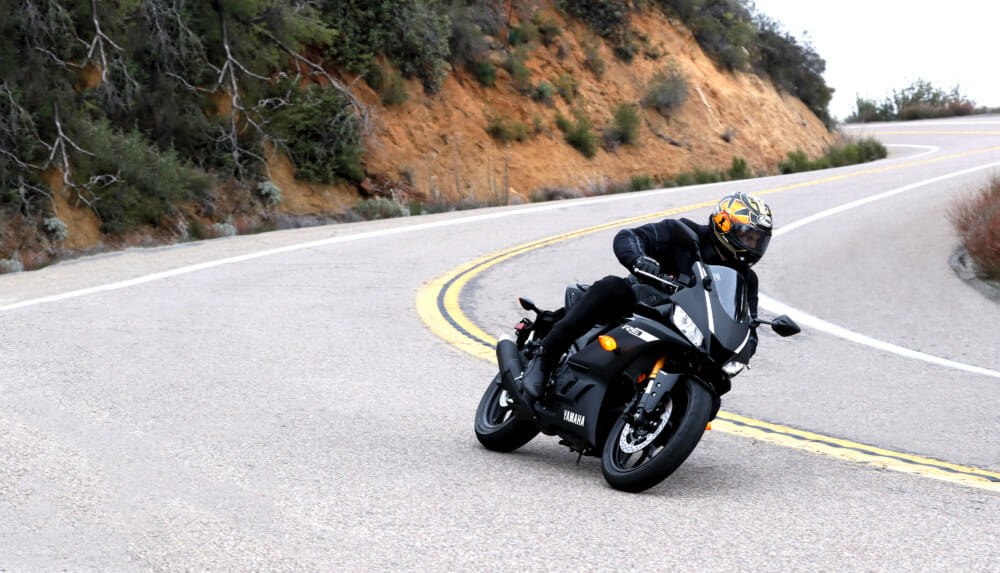 Get any blacker? We’re not big fans of matte black, but the R3’s matte black edition doesn’t look too bad.
Get any blacker? We’re not big fans of matte black, but the R3’s matte black edition doesn’t look too bad.
This is aided by the fact the front-end’s now inverted fork is 20-percent heavier in spring rate compared to the 2018 model. The fork is still non-adjustable, but braking balance is greatly improved with the compression and rebound damping figures both increased over the old machine. Yamaha has designed the spring rates to suit a wide variety of rider weights, so those looking for even more performance will need to start venturing into the realm of cartridge kits and stiffer springs, but the base front suspension settings and new fork offer a tangible improvement in performance for the model.
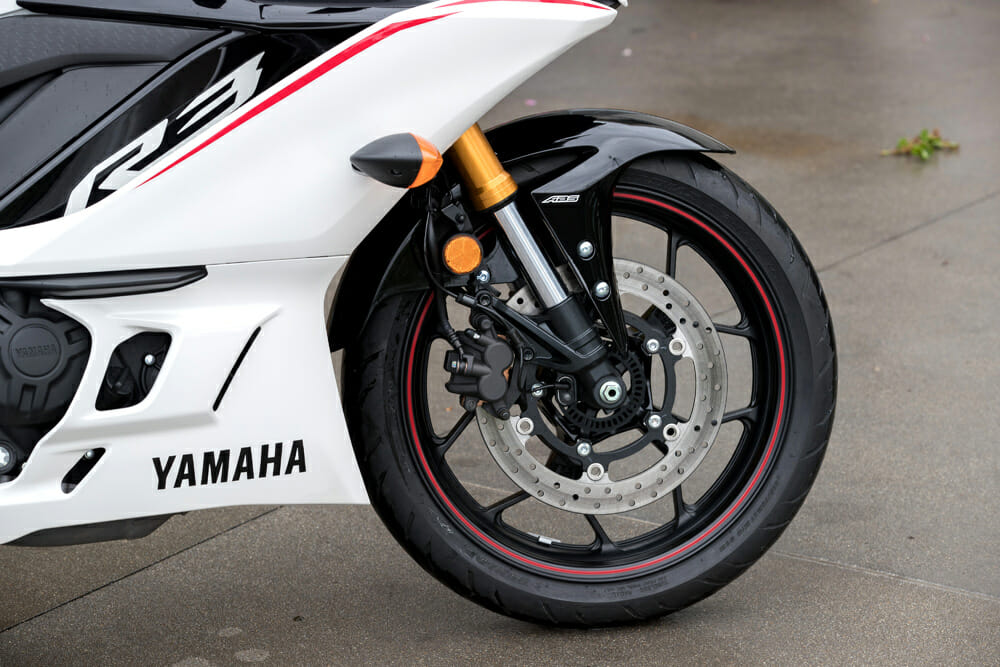 One of the biggest features of the new R3 is the fork and makes a big difference to braking stability.
One of the biggest features of the new R3 is the fork and makes a big difference to braking stability.
The rear suspension also sports an 11-percent heavier spring compared to last year and does an excellent job of ensuring the R3 stays on line when getting hard on the gas exiting corners and ensuring the chassis remains stable over bumps.
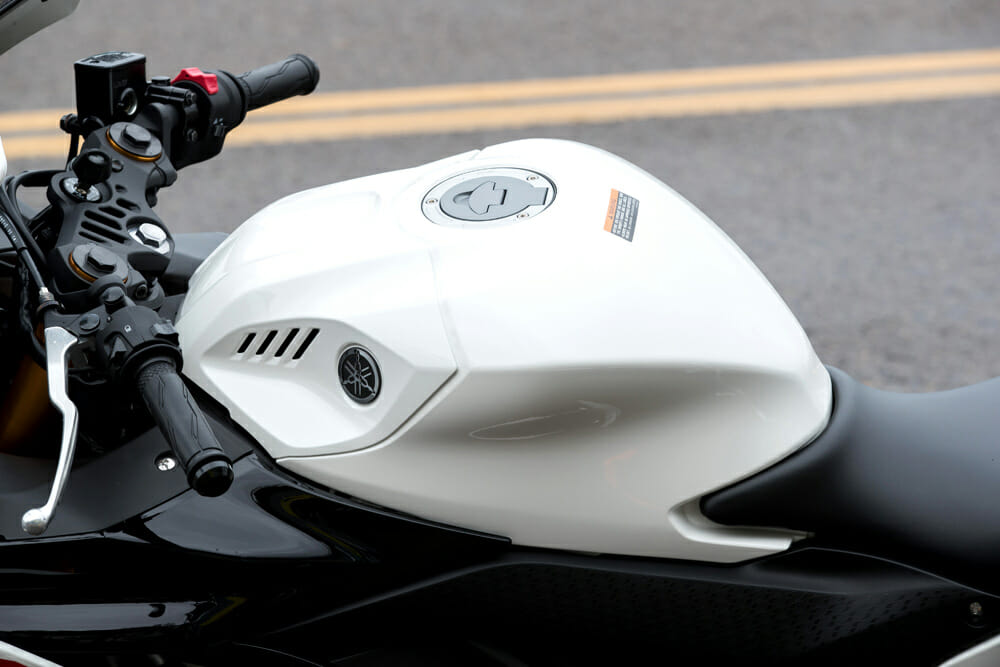 The new tank is 20mm lower than before and allows you to tuck in a little better.
The new tank is 20mm lower than before and allows you to tuck in a little better.
Unlike the front, the rear suspension has had the compression damping decreased to help accommodate the longer spring, although the rebound has been increased.
There wasn’t a huge amount wrong with the old bike in terms of stability on the street, but the new suspension settings front and rear give the chassis a bit more of a sporting edge and should translate to a better ride on the track.
What is a known quantity of the R3 is the base tubular steel chassis and the 321cc engine, both of which needed absolutely no fettling for this year. The engine is strong, as can be proven by the neck-wringing the thing gets every time it takes to a MotoAmerica Junior Cup grid. The twin-cylinder engine provides a solid spread of usable power although it does like to keep the revs relatively high to make it really sing. The good news is these high revs don’t necessarily translate into unwanted vibrations at the ’bars and ’pegs and means you can ride the R3 comfortably for longer periods than you might expect.
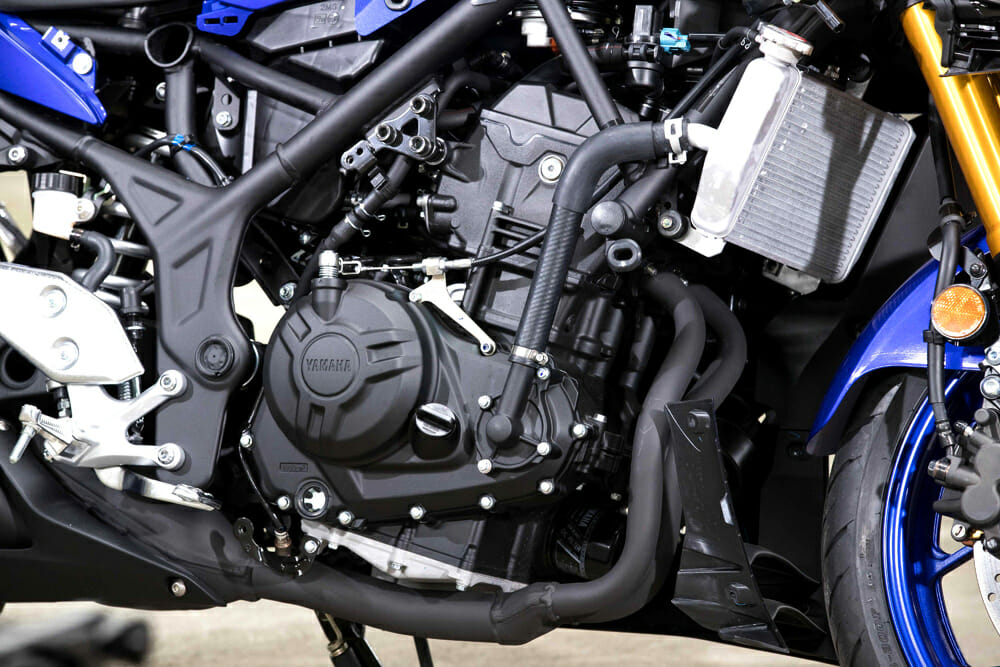 If it ain’t broke, don’t fix it. So, Yamaha has left the engine alone for 2019.
If it ain’t broke, don’t fix it. So, Yamaha has left the engine alone for 2019.
I was hoping Yamaha was going to join Kawasaki head-on this year by producing a 399cc version of their twin to call the bike a YZF-R4, but the powers that be at Yamaha decided against this butting of heads with their compatriots simply because they believe the current R3 offers the best combination of user friendliness, comfort, and power in the class.
Nevertheless, the R3 does indeed provide and excellent basis for riders to begin their sport bike journey. Yamaha has attempted to future proof the machine somewhat by giving it the new all-digital dash in the same shape as the R6, the revised styling, suspension changes and the new Dunlop rubber which, it must be said, handled the often wet and slick surfaces of our test route superbly. But underneath it all is basically the same bike as before, which proves Yamaha got this one pretty close to spot on when they released it back in 2015.
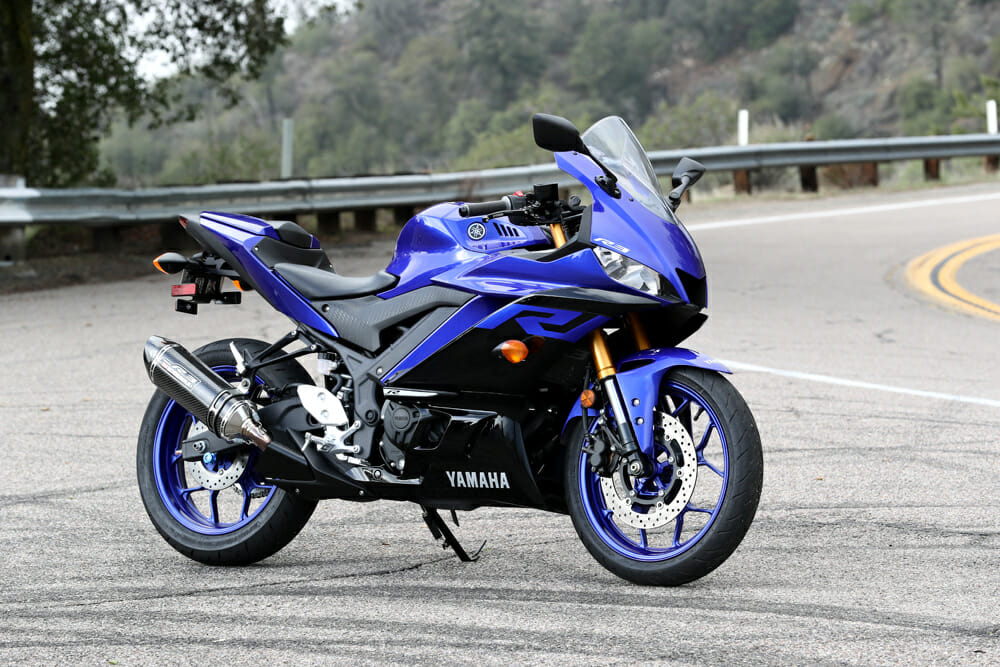 The accessory R3. Yamaha’s got a new taller screen, Yoshimura pipe and number plate holder to tidy things up at the back.
The accessory R3. Yamaha’s got a new taller screen, Yoshimura pipe and number plate holder to tidy things up at the back.
The changes wrought has improved the breed, and with the non-ABS machine selling for $4999 with a $300 premium for ABS, the YZF-R3 represents very good value for Yamaha’s little blue bike that could.CN
VIDEO | 2019 Yamaha YZF-R3 Review
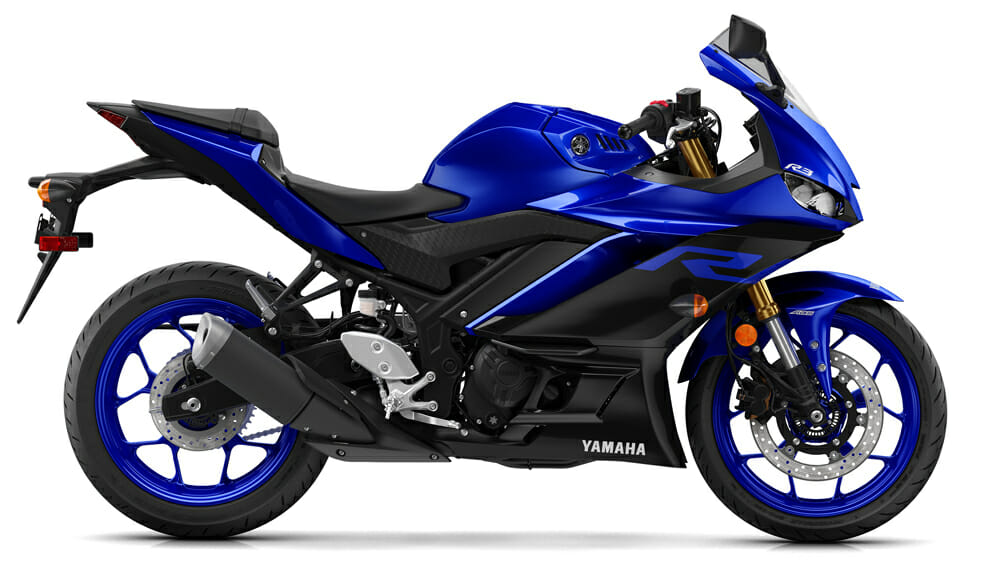
| SPECIFICATIONS |
2019 Yamaha YZF-R3 ($4999, $5299 ABS) |
| Engine: |
Liquid-cooled, DOHC, 8 valves, inline twin |
| Displacement: |
321cc |
| Bore x stroke: |
68 x 44.1 mm |
| Compression ratio: |
11.2:1 |
| Fuel system: |
EFI |
| Exhaust: |
2-1 |
| Clutch: |
Wet multi-plate |
| Transmission: |
6-speed |
| Front suspension: |
43mm inverted fork, non-adjustable |
| Rear suspension: |
Monoshock, preload adjustable |
| Front brake: |
Single 298mm discs, 4-piston caliper; ABS optional |
| Rear brake: |
220mm disc, 2-piston caliper; ABS optional |
| Front tire: |
110/70-17 in. Dunlop Sportmax GPR-300 |
| Rear tire: |
140/70-17 in. Dunlop Sportmax GPR-300 |
| Wheelbase: |
54.3 in. |
| Seat height: |
30.7 in. |
| Fuel capacity: |
3.7 gal. |
| Weight (wet, claimed): |
368 lbs./375 lbs. ABS |